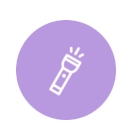
The Assignment:
Read about the assignment
The creation of this assignment for a first-year writing class in Fall 2014 was driven by several factors, including the interests of my students. I was aware of the application before that semester, but hadn’t realized the frenzy with which students were using it until they continued to bring up the app during our conversations about writing in digital spaces. As I read about controversies involving Yik Yak on other campuses at that time—controversies linked to the anonymous, localized nature of the application—I found myself thinking about the pedagogical benefits (and risks) that could come from utilizing this application in my classroom. Ultimately, I envisioned this assignment (click here for a PDF version) as an opportunity for students to explore the writing process via an anonymous, location-based application, an approach that highlights situational factors that are often overshadowed by author or creator identity.
Why Yik Yak?
Websites and applications that allow users to post anonymously, or to use screen names only loosely associated with their real identities, are part of many students’ everyday lives. Asking students to tap into the rhetoric "that does indeed engage with the living, hooking into the processes that are already in play" allows all of us to "find ourselves theorizing rhetorical publicness" (Edbauer, 2005, p. 23). The ubiquity of these platforms in the lives of students, as well as the possibilities that they provide for exploring mobile, digital composition, persuaded me to incorporate a short assignment that utilized one of these anonymous platforms into my course.
I eventually decided to use Yik Yak for three main reasons: first, its focus on text-based communication rather than images (the focus of other anonymous, location-based applications Whisper and Kandid); second, its geographically-based nature that made Yik Yak a good example of the mobile applications we had discussed throughout the class; and third, what Rebecca Tarsa (2015) would describe as the application’s "qualitative affordances," or the systems "through which readers’ opinions of a text are tracked and displayed back into the community" (p. 22). Yik Yak users were able to upvote, downvote, and reply to posts, which provided two different levels of engagement to users, and two types of feedback, as well. Tarsa argued that qualitative affordances provide an entry point for students to become more active on an application; Yik Yak’s tools, combined with the application’s real-time feed, offered a space where students could receive quick, tangible feedback on their posts. These features, as well as the popularity of Yik Yak at the time that I designed this assignment, provided students with the opportunity to interact and analyze a unique network in the context of our writing classroom.
Institutional Context
This assignment was implemented in several sections of English 106, the general first-year composition course at Purdue University, which attracts students from all disciplines to fulfill their writing requirement. The detailed learning objectives of this course require students to, among other outcomes:
- Demonstrate rhetorical awareness of diverse audiences, situations, and contexts;
- Critically think about writing and rhetoric through reading, analysis, and reflection; and
- Engage multiple digital technologies to compose for different purposes, including to "demonstrate rhetorical awareness of how technologies shape composing processes and outcomes" (English 10600 Learning Outcomes).
This Yik Yak assignment was designed with these particular outcomes in mind, as students were asked to consider audience and context through their observations and reflections on the application, as well as to engage with this digital platform in order to examine how it shaped their posts and the posts of others.
Purdue’s first-year composition curriculum is designed around established syllabus approaches, which allow instructors the freedom to utilize the texts and assignments that they find most useful, but also require them to meet the same outcomes. When I used this assignment, I was teaching in the Writing About Writing syllabus approach, which encourages students to develop high levels of genre awareness, to recognize and explore surrounding discourse communities, and to have conversations about literacy practices across a wide range of contexts (responding to the work of Elizabeth Wardle & Douglas Downs). As a way to meet these goals, I infused my course with digital and public writing to illustrate the immediacy of the concepts noted above, as well as to increase awareness of how "certain networks behave differently depending on tools, platforms, and contexts" (Daer & Potts, 2014, p. 32)—an awareness that Yik Yak, as an anonymous, hyperlocal application, could undoubtedly inform.
Course Context
Students worked on this assignment in the latter half of the semester, just after they had completed an extended research project on a discourse community in which they were interested or involved. Many students pursued research that incorporated digital presences of communities, and we spent a lot of time in class discussing the affordances and constraints of digital platforms as organizing tools for groups. This interest in the digital representation of physically-present groups lent itself to the next major unit, a remediation of student research projects into websites. As a way to help this transition from an admittedly traditional print essay to a digital project, I felt that an exploration of Yik Yak would provide students with the opportunity to utilize some of the vocabulary they had acquired earlier in the class (discourse, norms, rhetorical appeals, context, genre, template) and to focus specifically on digital spaces.
The Assignment Prompt
The assignment prompt asked students to complete three main tasks:
- Survey the Purdue Yik Yak feed to "get a comprehensive idea of the range of topics and posts that appear from day to day," and identify five topics that are commonly addressed;
- Pick two of the five topics they identified and compose their own posts, so that they can "see what works best—what gets the most upvotes, what disappears, and so on."
- Reflect on their experiences, and consider how "the features of the application contribute to the user’s experience," providing screenshots and examples from their own exploration.
After completing these three steps, we then spent an entire class session recounting experiences and working towards a shared understanding of the complicated nature of digital, mobile, anonymous communication. Overall, students were excited to pursue this project. Students who did express some hesitation (either because they had heard some unsavory things about the application, or were unsure about using social media applications in the classroom) engaged with the assignment in spite of their initial reaction. Further, many students commented during our discussions and wrote in their reflections that they were disappointed that they hadn’t had much experience writing about social media in academic settings up to this point, because this assignment helped them to think more carefully about their everyday writing practices. We also read and discussed some popular pieces about Yik Yak (Parkinson, "Yik Yak: The anonymous app taking US college campuses by storm" and Lapowsky, "How Yik Yak keeps its anonymity app from ruining people’s lives") to prepare for the types of posts that might be present on the application, and to make connections to overall course goals before students started working on the assignment.
I used this assignment during the Fall 2014 and Spring 2015 semesters, and the student reflections and screenshots in this webtext come from the work of 31 first-year composition students who agreed to share their work for this study. The Purdue Institutional Review Board approved this study, and all of the responses used in this webtext have been gathered and assembled via IRB-sanctioned means; for example, all students willing to contribute their work signed consent forms and their names have been changed.
Potential Issues (and Alternatives)
When planning this assignment, I considered the reality that not every student would have a smartphone (or want to download this application onto their device). Anticipating this, I provided students with the option to work in small groups of 2-3 members. Several students did complete the assignment collaboratively, and even though access to technology was a topic of discussion throughout the course, no students mentioned anything about access in their reflections. This gap reveals that access is a concept that needs to be further explored with such assignments. In order to truly understand the power dynamics inherent in the usage of different technologies, students must be aware of the social, material, and economic barriers for access, especially with mobile technologies.
After completing this project during the fall semester, I thought more about the possibility that students would not want to engage with this particular application, given the potential for hostile posts or privacy concerns. I offered students the option to request an alternative assignment during the Spring 2015 semester, but no students did so. If students had requested this, however, I would have invited them to examine a similar platform; that is, a web or mobile network that wasn’t based on personal profiles and pre-existing social networks. While students would perhaps not be able to see the effects of geographic place as clearly as they might with a mobile, location-based application like Yik Yak, they would assumedly observe the other shaping factors pointed out in this webtext because of the differences in how networks were being built. (And many discussion boards do have a local aspect to them, like the sub-threads on Reddit that are focused on specific campus communities.)
By asking students to observe, analyze, and create using the tools in Yik Yak, I hoped to increase their awareness of the complexities woven into the seemingly neutral tools we use daily (as suggested by Selfe & Selfe, 1994). I also designed this assignment to encourage students to reflect on their roles and accompanying responsibilities in digital ecologies, especially those which they inhabit every day. I felt that the anonymous and hyperlocal nature of Yik Yak created an environment that would encourage students to focus on the discourse circulating on the application, rather than who was posting it. Additionally, as opposed to more familiar, profile-based applications, this application didn’t require students to spend time setting up a personal page; instead, they could jump right in and observe how discussions were going on the application, which made the assignment easier to introduce.
While I used Yik Yak as a means through which students could observe these situations, the overarching goal of this assignment can be pursued with a variety of anonymous social media applications. As I noted above, no students in Spring 2015 asked for an alternate assignment, but if they had, these would have been some of my suggestions:
- Any number of college confession websites, which allow users to post and reply anonymously (and are assumedly some of the forerunners of applications like Yik Yak);
- Imgur, an image-hosting site with a robust social network of "imgurians" who often organize regional, in-person meetups;
- Reddit, a discussion board website with countless sub-reddits dedicated to topics, places, and identities, including college campuses (Purdue included);
- Imzy, a discussion website founded by former employees of Reddit and Twitter, meant to be a friendlier, more welcoming space;
- Quora, a question and answer site that allows users to browse, post, and answer questions with a social network feel;
- Fluther, another question and answer site designed to be a bit more like a traditional discussion board site; and
- Next Door, a social networking site that allows users to join message boards about their physical neighborhoods.
Though these platforms encapsulate various levels of anonymity and different orientations to physical place, I thought that they would still allow students to explore the shifting forces within these discursive environments, given that none of them focus as heavily on building profiles (and accumulating content on those profiles) as sites like Facebook, Instagram, and Twitter do. Further, they all have been designed as discussion hubs, featuring many opportunities for users to engage via commenting, upvoting, favoriting, and so on. This is by no means a comprehensive or even up-to-date list, given the speed with which platforms rotate in and out of use, but these represent the types of applications and sites that could be especially useful in highlighting the presence of nodes within the dynamic writing environments they inhabit.
While anonymous (or semi-anonymous) platforms illuminate the presence of nodes beyond the poster’s identity perhaps more clearly than profile-based sites and apps, there are still portions of more traditional social media platforms that could allow for the types of explorations discussed in this webtext: mainly, the public-facing discussion features. While Facebook is designed explicitly for users to link their digital and physical identities together, users who aren’t connected in real life can connect with one another through fan pages and groups, relegating profiles to a lesser degree of influence, thereby highlighting other factors in composition. Twitter and Instagram, which allow users to link their online profiles and their physical identities but do not require it, could also provide students with a similar environment to the applications discussed above. Obviously, the parameters of an assignment using profile-based applications would be different, but students could still explore the way that anonymity shapes online discussions in these spaces that we don’t typically see as anonymous. Examining the role of anonymity, in a range of applications, allows students to see the interplay of other situational factors like time, place, relatedness, and interruptions in relatedness.








